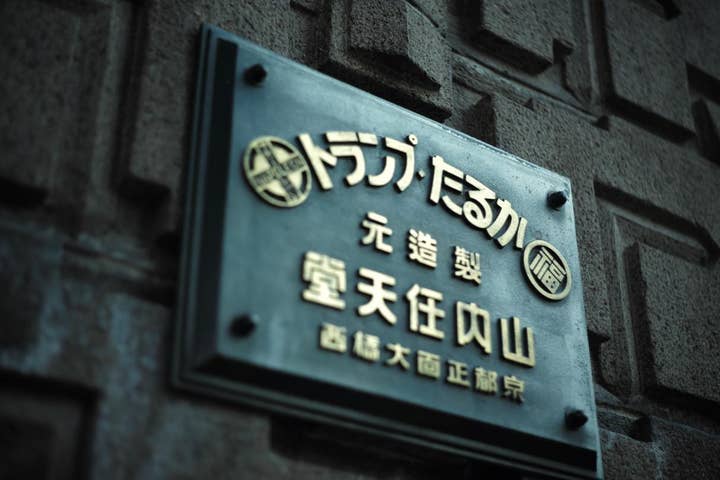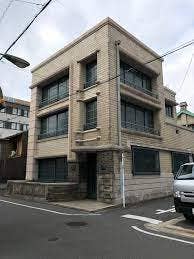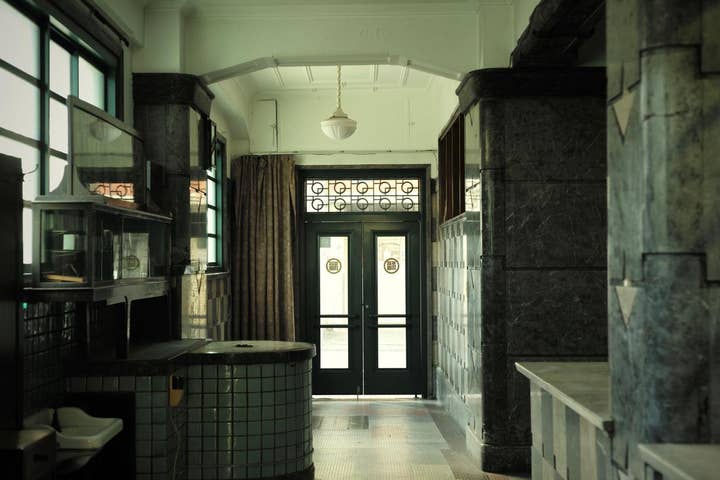The birthplace of Nintendo
Now converted into a hotel, we take a look at the former headquarters where the Mario maker transformed into the company we know today
Last month, the Marufukuru Hotel opened at 342 Kagiyacho in the Shimogyo-ku ward of Kyoto. Upon approach, guests might be surprised to find a small green plaque beside the entrance. Emblazoned with gold characters, the sign reads, "Playing Cards, Yamauchi Nintendo."
While not as iconic as Nintendo's beige-bricked square in south Kyoto, the building's importance should not be underestimated. Prior to its move to 342 Kagiyacho, the company operated out of a number of smaller, disparate sites. It was there that the process of consolidating Nintendo into Nintendo Co., Ltd began and, under the leadership of Hiroshi Yamauchi, pivoted to gaming and the success that has made it a global household name today.
The flowers of Kyoto
The story of Nintendo does not begin in the 1980s with Hiroshi Yamauchi, but a century before. Nintendo Koppai was founded in 1889 by Fusajiro Yamauchi, an artisan of karuta: playing cards. Not as we know them in the West, however. Rather, Fusajiro made hanafuda or 'flower cards.' Dutch and Portuguese merchants introduced playing cards to Japan in the 1500s, but hanafuda trace their history back further to games played with painted shells. Hanafuda are smaller and thicker than typical Western cards. A deck comprises twelve suits, each designated by a flower, and they can be used for a variety of games.

Japan banned gambling in 1882 "in order to nurture a work ethic." Authorities, however, tolerated hanafuda as they lacked numbers or designations of value. In lieu of other betting opportunities like horse racing or dog tracks, yakuza set up high-stakes hanafuda parlours to entice the gamblers of Kyoto.
This drove many companies to stop making hanafuda, concerned about their association with the criminal class. Fusajiro had no such qualms. Nintendo quickly became the most successful hanafuda manufacturer in Kyoto, with the yakuza its most prominent customer.
This success allowed Fusajiro to expand. He trained apprentices to mass produce cards and in 1902 incorporated Western-style playing cards that were quickly becoming popular on the archipelago.
When he was ready to retire, thanks to a distribution deal with Japan Tobacco & Salt Co., Nintendo's cards were being sold across Japan. But without a son to whom he might pass the business, Fusajiro arranged for his daughter, Tei, to marry Sekiryo Kaneda. As remains customary in Japan -- where 98% of adoptions are of adult men -- Fusajiro adopted Sekiryo into the Yamauchi family and, in 1929, installed him as the second president of Nintendo.
Under Sekiryo, the company rebranded as Yamauchi Nintendo. The business rumbled on until 1933, when it moved to a new, modern headquarters Sekiryo had built beside the original building. Later, in 1947, Sekiryo founded Marufuku Co. to handle distribution of Nintendo's large orders of Western playing cards.
Sekiryo, too, left no son to carry on with his work. His adoptive son absconded when Sekiryo's daughter gave birth to a boy, Hiroshi, and it was to him that the company ultimately passed.
The new guard
Hiroshi Yamauchi became Nintendo's third president in 1949. US Gamer described him as "the iron fist concealed within the velvet glove" -- an apt description for a slightly diminutive figure renowned for his severity. But behind that facade, Hiroshi was a shrewd, forward-thinking businessman. He was happy to take a chance on and nurture young talent, to chase new ideas, but brooked no question of his authority.
Hiroshi Yamauchi's first act as Nintendo president was to let go of anyone connected to his grandfather's conservative leadership
His first act as Nintendo president was to let go of anyone connected to his grandfather's conservative leadership. Having cleared house, he consolidated Nintendo's design and manufacturing in 1951, housing both at 342 Kagiyacho and rebranding Marufuku Co. to Nintendo Karuta.
Hiroshi modernised Nintendo's manufacturing and, in 1953, began producing Japan's first plastic playing cards. But he had ambition beyond his great-grandfather's business -- a feeling that was reinforced when he visited the US in 1956 and saw the industry was slowly dying. If Nintendo hoped to survive, it needed to diversify. A deal with Disney in 1959 helped Hiroshi broker new relationships with toy shops and department stores, and made Nintendo a familiar name to younger consumers. But, to Hiroshi, it was ultimately a static move.
Despite selling 600,000 packs in 1959, Hiroshi took the company public and dropped "karuta" from the name. Now Nintendo Co., Ltd, the company moved once more and embarked on its first venture outside playing cards: a failed line of instant rice.
Undaunted, Hiroshi launched a successful taxi company. Then a chain of love hotels -- of which Hiroshi was reportedly a frequent patron. It was here that Nintendo's relationship with the criminal underworld reared its head once more, as Hiroshi allowed yakuza to run prostitutes through company hotels. But he wearied quickly of dealing with drivers' unions and increasingly brazen yakuza, and shuttered both businesses.
Keen as he was to leave the past behind, Hiroshi had lost sight of what Nintendo excelled at. Looking at his distribution networks, he realised Nintendo was, and always had been, an entertainment company -- and it was in entertainment that the future lay.
Fun and games
Nintendo signalled its entrance into the world of toys and games with the Ultra Hand, designed by Gunpei Yokoi. Yokoi was an electronics graduate hired to maintain Nintendo's assembly line. Hiroshi quickly saw potential in the young engineer and assigned him to Nintendo's new games division, telling him, "Make something great."
His first product sold 1.2 million units. Yokoi's division grew and with it the rate at which Nintendo pumped out new toys. Where other companies were content importing the latest Western fads, Hiroshi wanted original ideas. To this end, Yokoi and another Nintendo engineer Masayuki Uemura started experimenting with small solar cells which developed into the Laser Clay Range, a light gun shooting range and Nintendo's first step into arcade gaming.

Hiroshi grew increasingly fascinated by the industry's growing potential. In 1974, he negotiated a deal to distribute Magnavox's Odyssey home console in Japan before agreeing with Mitsubishi to develop similar products between 1975 and 1978.
The result was the Color TV-Game 6 and its follow-up the Color TV-Game 15. Successful though they were, Nintendo wasn't in a healthy position. The 1973 oil shortage had rocked the country's economy. While Japan continued to shift focus from oil to nuclear power and greater energy efficiency, Hiroshi shifted Nintendo's to creating something truly novel.
But Yokoi said the "Nintendo way of adapting technology" was not to look for the state-of-the-art but to "utilise mature technology that can be mass-produced cheaply."
While Hiroshi watched the success of games like Space Invaders with envy, Yokoi was considering something much smaller. He began experimenting with the miniaturised technology found in pocket calculators and in the process designed the Game & Watch. Small, fiddly, and wildly popular, it made Nintendo millions. It also lost millions to bootlegs sold across Japan -- worth noting when we consider Nintendo's aversion to external emulation and preservation.
The Game & Watch brought Nintendo back into the ascendency, and Hiroshi's focus on the profit potential of the growing market of arcades led to popular games like Hellfire, Radarscope, and later Donkey Kong. But behind the scenes of this success, Nintendo's design teams were working on something else. Something new, something revolutionary.
Changing lanes
History recognises Ralph Baer's 1967 "Brown Box" as the first home video game console. A rudimentary system by modern standards, it hooked up to the TV and played simple, dedicated light games reminiscent of Pong.
In 1973, Magnavox released the Odyssey. The console utilised a system of cards that, when inserted into the console, modified the internal circuitry to change inputs and even display different components. It inspired Lawrence Haskell and Wallace Kirschner at Alpex to develop a simpler technique for consumers to add games to a console. Haskell figured that Alpex customers would shell out more for hardware if they knew they could buy relatively inexpensive modules that allowed them to play a potentially infinite number of games.
If we remember the people that worked there and how their games influenced our lives, the building can retain its Nintendo heritage long after it's been put to other uses
When Fairchild bought Alpex's prototype, it became a priority to make the modules more user-friendly. Industrial designer Nick Talesfore used the then-popular 8-track tape as inspiration; their solid casing made them perfect for the inelegant procedure of changing tapes in a moving vehicle and now Talesfore adapted them for the clumsy hands of untrained gaming consumers. The video game cartridge was born.
Fairchild's Video Entertainment System -- later dubbed the Channel-F -- debuted at the end of 1976. It experienced solid sales, but it's difficult to recognise it as the revolution it was with 350,000 units sold. Its catalogue of basic games struggled to maintain its small market lead once the Atari 2600 released in September the next year.
Hiroshi disagreed with Haskell. He reasoned that an inexpensive console would make consumers more willing to spend later on software, where he believed the real money in gaming lay. But Nintendo learned from Fairchild and Atari. With the Bandai Intellivision and MSX already providing similar experiences in Japan, Nintendo's games needed to be more exciting, more interactive, more everything.
To explore this, Uemura tapped into Nintendo's arcade developers. Not for technical knowhow -- Nintendo's home consoles could never keep up with the arcades' bigger processors -- but for the thinking behind making players come back to a game they already lost over and over. He believed games could be more colourful and complex, more of a reflection of reality than those found on the Atari 2600.
To implement what he learned, he needed better hardware. Most companies refused to provide chips for Nintendo's fledgling concept at Hiroshi's prices. He wasn't blind to his designers' needs though, but for the system to be the success he envisioned he would need to get the chips they needed at the prices he wanted. In a bold gamble, he guaranteed Ricoh a three-million chip order if they supplied them at his price. Most manufacturers were selling 20-30,000 units, but Hiroshi impressed upon Ricoh that Nintendo's new system was going to be bigger than anything that came before it. It was an offer Ricoh could not refuse.
Hiroshi directed his designers to cut out anything that might drive up the price or scare off computerphobes. This system was for everyone. It could hook up to a modem and keyboard, but shipped with a simple, user-friendly controller: two buttons and a directional pad. It was also the most powerful console available, with 2000 bytes to the Atari's 256; so, too, could Nintendo's cartridges handle significantly more code than the 2600's. It was bigger, better, more accessible, and more versatile than anything else on the market -- and most importantly, it was cheaper.
The name Hiroshi gave the machine? The Family Computer.
When Nintendo unleashed the Famicom on Japan, it sold 500,000 units in its first two months. Retailing for half the price of its competitors, this unthreatening red and white box flew off shelves. Wholesalers worried about the low price, but Hiroshi dismissed their fears.
"Forgo the profits on the hardware," he said. "It is really just a tool to sell software."

The rest is history
Within a year, Nintendo's competitors vanished, unable to keep up with the Famicom's popularity. Nintendo became a haven for engineers and video game artists, launching the careers of some of the industry's most-revered pioneers. Hiroshi maintained a focus on software, and the release of Super Mario Bros. in 1985 and The Legend of Zelda in 1986 -- both the brainchild of Shigeru Miyamoto -- proved Hiroshi's instincts correct and cemented Nintendo as the peerless leader of the industry.
For Nintendo, it was a space of consolidation and transition; a bridge between Nintendo's conservative past and the diversification that led it to where it is today
Not that there weren't drawbacks to the value Nintendo put on software. To avoid the losses of the Game & Watch, Hiroshi guarded the Nintendo's cartridges fanatically. Third-party developers were forced to buy cartridges from Nintendo at 2,000 yen per unit (twice what they cost to manufacture) with a minimum order of 10,000. It was exploitative, for sure, but with many games selling hundreds of thousands of copies, it was lucrative for all parties -- and on those occasions it wasn't, it was still lucrative for Nintendo.
By 1988, Nintendo boasted fifty third-party developers under its auspices, all buying cartridges as fast as Nintendo could make them. Sales in Japan were decent, but it was the redesign of the Famicom for Western markets as the Nintendo Entertainment System which consolidated Nintendo's position as not just the biggest name in gaming, but as one of the biggest brands in the world.
When the Marufukuru Hotel opens, it does so in Nintendo's oldest building (the company's first headquarters was demolished in 2004 ) and amid the rich, and sometimes unexpected, history of one of Japan's wealthiest companies. The hotel commemorates its origins, but the more cynical among us will regard this as marketing rather than sincere deference to the building's history.
Yet, perhaps it is apt that this place, in particular, becomes something else. For Nintendo, it was a space of consolidation and transition; a bridge between Nintendo's conservative past and the diversification that led it to where it is today.
As Yokoi said, Nintendo always adapts mature technology and, empty since 1959, the old headquarters at 342 Kagiyacho is certainly mature. The building may lose much of its identity -- a bit of its soul -- when it opens as a hotel. But in the end, the history of Nintendo is a history of people and so it is what we ascribe to these places that matter.
If we remember the people that worked there, how their games influenced our lives, and brought joy to millions, the building can retain its Nintendo heritage long after it's been put to other uses.